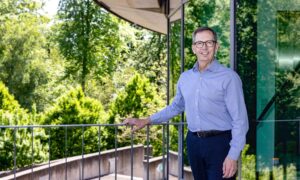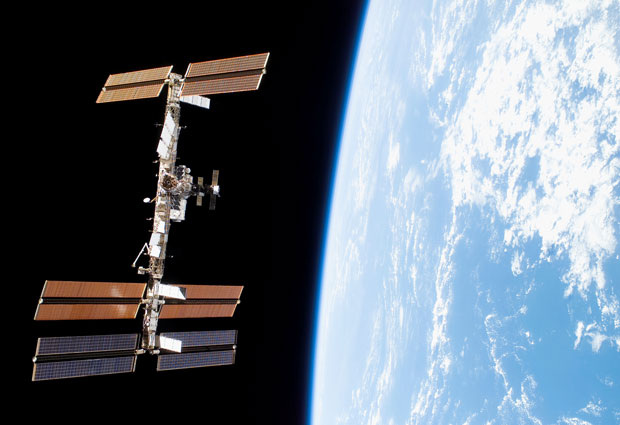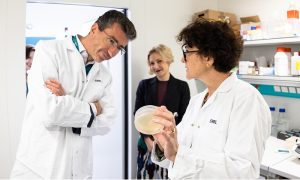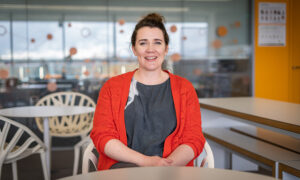
Science in space
EMBL alumna Sigrid Reinsch trained as a cell biologist – now she helps run experiments in space

It’s the weekend. You’re indoors, working on a job application. Outside, there are voices and cars, the broad blue of the San Francisco Bay, and – a few hundred kilometres up – the silence of low Earth orbit. At that altitude, there’s not much: some tenuous air, the occasional piece of space debris, and a lone space station – Mir. Inside, an astronaut drifts over to inspect some wheat seedlings growing in a small steel chamber under artificial light. These plants will help determine whether humans on long-term exploration missions might one day feed themselves by growing crops in space.
For now, you have more worldly concerns. You need to feed yourself and your young family – not by growing crops in space, but by finding a job on Earth. The position you’re applying for is at NASA, where big things are in progress. Some 3,000 km to the east of you in Huntsville, Alabama, work is being completed on the Unity module – the first US-built component of what will become the International Space Station (ISS). When Unity is launched and joined to the Russian Zarya module later in the year, the ISS – and its programme of scientific research – will start to become a reality. A job at NASA ought to be an exciting prospect, but somehow you’re not convinced it’s the right thing.
Problems on Earth
That was the situation for EMBL alumna Sigrid Reinsch in the spring of 1998, when she was coming to the end of a postdoc position at EMBL in Heidelberg. After six years living in Germany, she was looking for a job back in her home country. “I applied for tons of university positions in the US and none of the applications worked out,” she says. “I ended up going on a US tour and trying to figure out what other types of jobs I could do. In desperation, I was hanging out in a friend’s office in San Francisco and she told me about this job at NASA.”
At that time NASA was looking to expand its space biology programme, a major component of which is research relating to long-duration spaceflight. This includes experiments to determine the effects of radiation exposure or weightlessness on humans and other organisms. Most of NASA’s space-borne biological experiments were being carried out on Mir and on Space Shuttle missions, gradually transferring to the ISS following the arrival of the first crew in 2000, the deorbit of Mir in 2001, and the end of the Space Shuttle programme in 2011. When Reinsch was applying for a job in 1998, NASA was aiming to recruit more scientists with training in cell and developmental biology.
EMBL was like the Disneyland of biology: any experiment you could think of, you could do
The position she applied for was for someone with experience of research on the cytoskeleton – the network of protein filaments and tubules that gives cells their structure, and which is involved in processes like organising the cell’s contents, cell migration, and cell division. The cytoskeleton had been the subject of Reinsch’s PhD and her subsequent postdoctoral work in Eric Karsenti’s group at EMBL, so she decided to apply. She was keen on the biological research aspect of the job, but had no particular interest in spaceflight experiments. “I felt very strongly that we have enough problems on Earth that we should focus on,” she recalls, “rather than doing experiments in space.”
Reorientation
Almost twenty years after accepting a job offer from NASA, things are a little different. “My opinion has changed,” says Reinsch with a smile. Initially her work at NASA involved research on the clawed frog Xenopus, an important model organism in biological studies. This included research on the development and functioning of the vestibular system – that part of the inner ear that assists with balance and spatial orientation, and which is often disturbed in conditions of weightlessness. Later she worked on projects focusing on the development of biofuels, which NASA is considering as a possible energy source for long-term human space exploration. Since 2014 she’s been involved in the GeneLab project, which aims to maximise the scientific return from experiments carried out on the ISS. “The purpose of GeneLab is to get the biggest bang for the buck out of any spaceflight experiment,” Reinsch explains. “We don’t change the funded, peer-reviewed proposal for an experiment but we investigate whether we could carry out additional analyses or add components to augment the experiment in some way.”
An important component of GeneLab is an open access database to house various types of biological data, not only from spaceflight experiments but also from ground-based experiments with important implications for space research, such as experiments that simulate weightlessness or study the effects of radiation. “The database is very easy to use,” says Reinsch, “and it’s designed to encourage collaboration between research groups.”
Taking on tardigrades
While much of Reinsch’s early career involved research on frogs, she’s recently branched out into working with various invertebrate species, including tardigrades. These are microscopic creatures typically less than a millimetre long that live in almost every environment on Earth, including deserts, the deep sea, and the poles. They’re famous for being able to enter a state of suspended animation by vastly reducing the water content of their bodies. This allows them to survive extreme conditions including temperatures just a degree above absolute zero and higher than the boiling point of water, pressures many thousands of times higher than atmospheric pressure, and radiation levels that would be fatal to most animals. They’re also the only animal to have survived the vacuum of space, as demonstrated in an experiment carried out by the European Space Agency (ESA) in 2007.
This extreme resilience, and the biological mechanisms behind it – such as an ability to protect DNA from radiation damage, or repair it afterwards – make tardigrades an interesting animal for scientists seeking a way to help humans and other organisms tolerate long-duration spaceflight. An understanding of the limits of endurance of terrestrial organisms can also assist astrobiologists in identifying places to search for life in other parts of the solar system.

Reinsch’s work with tardigrades came about when she was asked to explore alternative uses for a piece of ESA-designed hardware known as the European Modular Cultivation System (EMCS). Reinsch and her colleagues demonstrated that the EMCS – originally designed for plant growth experiments – could successfully support a range of other organisms including bacteria, brewer’s yeast, Dictyostelium (a type of slime mould), nematode worms, and tardigrades. “That’s how I got into working with tardigrades,” she explains, “by taking this cool piece of hardware and saying, ‘OK, besides plants, what else can we use it for?’”
Reinsch is currently technical monitor for another experiment involving tardigrades, led by Tom Boothby at the University of North Carolina. Boothby’s experiment will monitor both immediate and long-term changes in gene activity over several generations of tardigrades living on the ISS. The hope is that understanding the genetic changes that allow tardigrades to cope with the stresses of spaceflight will help in developing methods for humans to more safely spend prolonged periods in space.
A different kind of science
Research in space presents many challenges. The chemicals that might be used in a typical lab experiment are not all approved for experiments on the ISS, and many levels of containment are required to ensure that chemicals can’t escape. And something as simple as liquid transfer becomes a major problem. “In microgravity, a droplet won’t drop into a container, so you need a syringe-like apparatus to transfer liquids,” explains Reinsch. “Spaceflight experiments also have to be very minimalistic. The astronauts on the ISS don’t have a lot of time to devote to experiments, so in large part the experiments have to be able to run themselves. You also have a limited number of samples and you don’t get a chance to run the same experiment multiple times. You really have to plan effectively and anticipate any problems that might occur.”
For Reinsch, this approach to science has definitely required some adjustment. “I had a great time working at EMBL. To me, it was like the Disneyland of biology – any experiment you could think of, you could do,” she says. “With spaceflight research there are all these extra constraints you have to deal with. I’ve had to learn how to do science in a very different way.”
Studying life is really wonderful and always continues to astound me
When asked if she’d like to be one of the astronauts up there doing experiments, Reinsch remains practical. “In my mind, yes; in my body, no. I have problems just going on a boat, so I think I’d find it difficult dealing with the disorientation of being in space. Also, the fluids in your body migrate upwards because they’re not pulled down by gravity, so you have a lot more fluid in your head than you’re used to. I’m already prone to headaches so I think that would be a really bad idea for me,” she explains. “But if I could go and not have any of those physical problems, of course I’d love to. It would be very cool.”
Despite her initial scepticism about spaceflight research, Reinsch is now enjoying the role she plays in getting the best science from the ISS, and is keen to see what discoveries will emerge. “There are so many things I want to know, let me tell you,” she says. “My curiosity is hard to corral, and NASA is a great place for someone with a curious mind. Studying life is really wonderful and always continues to astound me. Getting to do that is the best thing that could ever happen to me.”
 Curiosity is a profoundly human trait. We start asking questions almost as soon as we learn to speak and continuously redefine our understanding of the world by questioning it. This is the driving force behind science, technology, engineering and maths. As part of our curiosity editorial theme, we are exploring what EMBL is curious about.
Curiosity is a profoundly human trait. We start asking questions almost as soon as we learn to speak and continuously redefine our understanding of the world by questioning it. This is the driving force behind science, technology, engineering and maths. As part of our curiosity editorial theme, we are exploring what EMBL is curious about.
Read more articles about curiosity and where it can take you.



